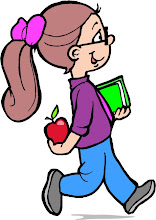Homeschooling I often need to remind myself of Cynthia Tobias' question, "What's the point?" Point being defined as aim, goal, desired outcome.
Here's an example: Sometimes we have work pages. You know the kind, five letters down the left side of the page and five pictures down the right side. The child is to draw a line matching the letter to the picture of the object that begins with that letter. Simple, right?
I'm not sure if it is normal or abnormal children that draw a single straight line from letter to object, or maybe it is children who are (or were, like me) conditioned in a classroom situation that is the way it must be done, but K. never learned that, so she likes to make her lines wander about a bit before ending up at the desired destination. It isn't that she doesn't know where to draw the line, she'll tell me before she starts her line, this is just more interesting, or something.
Now, it is easy for me to get frustrated because it is much simpler, faster, easier, etc. to draw a straight line. So that is when I need to step back mentally and ask, "What's the point?" Is the point on this worksheet to be able to draw a straight line? No! The point is that she knows 'apple' starts with A and 'elephant' starts with E. Does her wandering line show that? Yes! So we've come to a compromise. It is okay for lines to wander, but each line must be a different color so I can easily tell what was matched.
Then next time you start to get frustrated, step back and ask, "What's the point?" It may save you and your child some unnecessary frustration.








